We have a strict honest review policy, but please note that when you buy through our links, we may receive a commission. This is at no extra cost to you.
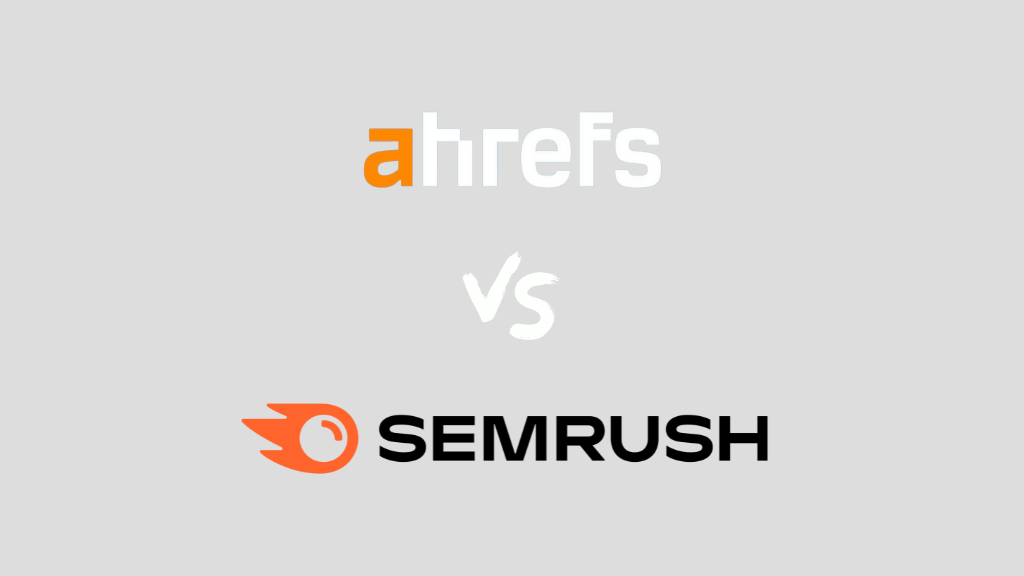
Ahrefs vs Semrush: which is better? I’ve tested both tools extensively, and in this comparison I share my findings and help you work out which one is the right fit for your SEO project.
Quick verdict
Ahrefs is generally a better fit for agencies or large companies managing multiple sites — it supports unlimited verified domains and, on higher-tier plans, unlimited reports, making it excellent value for SEO at scale.
However, for solopreneurs, small businesses or organizations that want access to more marketing data, Semrush is the stronger option. Its entry-level plan offers far higher reporting limits than Ahrefs’ equivalent, and its extra tools — for ads, content creation, CRM-style link outreach, and integrations — make it a true all-in-one marketing platform.
| Key reasons to use Ahrefs | Key reasons to use Semrush |
| More generous project limits | Entry level plan is much better value than the Ahrefs equivalent |
| Can be used with unlimited domains, so long as you own or can verify them | Doesn’t just provide just search data but detailed marketing data too |
| Better broken link analysis tools | Better site auditing tools |
| Provides more detailed SERP analysis | Gives you daily rank tracking reports |
| More generous link intersect features | Phone support is provided |
I’ll start the full comparison off with a quick overview of both tools.
Ahrefs and Semrush: an overview
Ahrefs and Semrush are two platforms that are primarily designed to help you optimize your website for search engines.
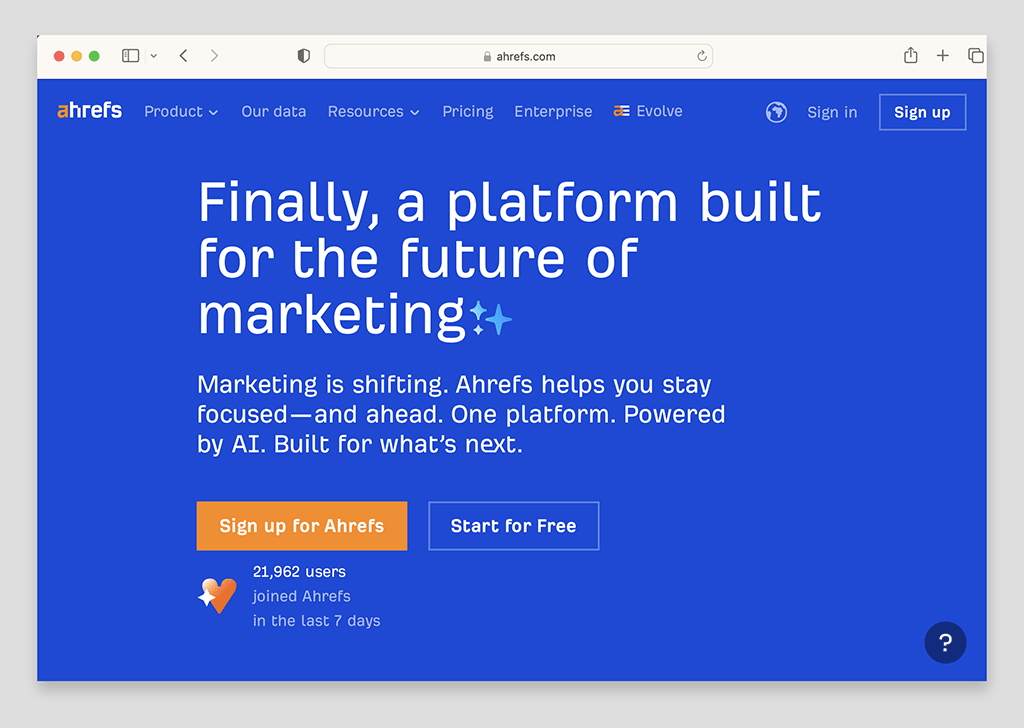
They do this in lots of different ways, but the main thing they give you is information — data that you can use to:
- get an overall sense of a domain’s authority and ranking potential
- find out what people are searching for in your business niche
- create new content that is likely to attract organic search traffic
- identify opportunities for building links from other sites to yours
- change technical aspects of your website in ways that will help it perform better in search results.
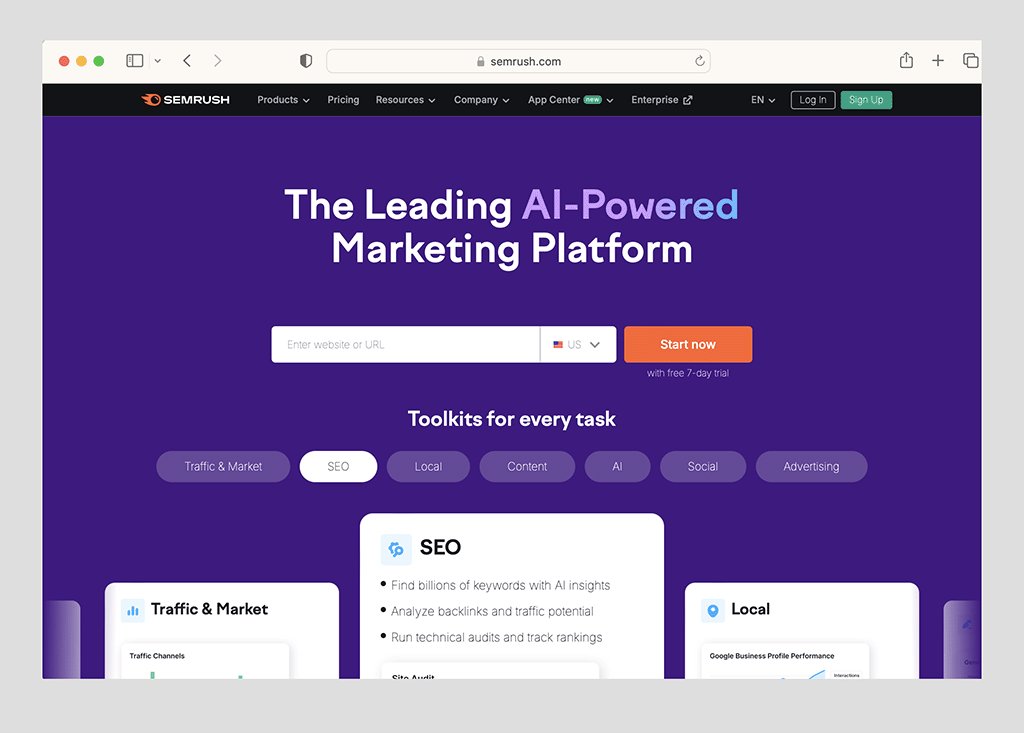
In truth, Ahrefs and Semrush are very closely matched in terms of the sort of data and features they give you — and this makes deciding between them very difficult! But there are some key differences that are really worth knowing about, because they’ll make one or the other a better fit for you. So in what follows, I’m going to flag these up.
I’ll start with the key edges that Ahrefs has over Semrush, and then move onto the areas where Semrush wins.
Reasons to use Ahrefs over Semrush
1. Ahrefs lets you track more domains than Semrush
If you need to work on multiple SEO projects involving lots of different websites, Ahrefs may be a better option for you than Semrush.
This is because Ahrefs lets you track the SEO performance of an unlimited number of verified domains. A verified domain is one that you can prove you have access rights to — you do this by connecting your Ahrefs account to Google Search Console, adding a DNS record to your domain, or adding some HTML to your site.
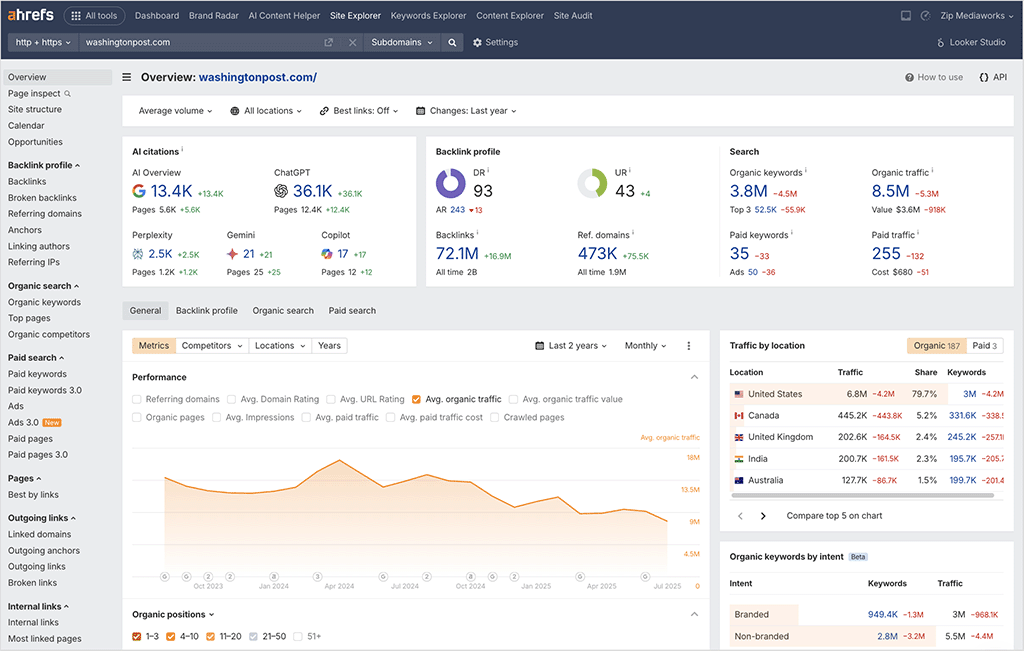
By contrast Semrush applies strict limits to the number of domains you can track across all its plans.
This means that if you run an agency that handles multiple SEO clients, or a company that operates multiple brands, Ahrefs may be a more obvious choice for you.
2. Ahrefs lets you access unlimited reporting
So long as you’re on its $249 per month ‘Standard’ plan or higher, Ahrefs lets you pull an unlimited number of SEO reports.
Semrush, by contrast, applies limits on all plans to the number of reports you can run. By comparison to competing tools, Semrush’s limits are very generous, but they still result in less reporting flexibility than Ahrefs provides.
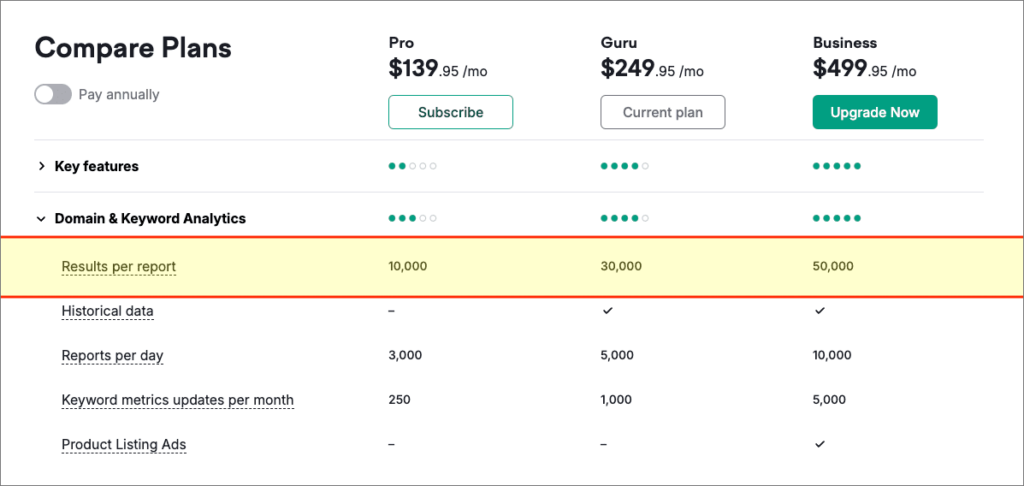
3. The Ahrefs traffic potential feature lets you see the true value of ranking highly for a keyword
While Ahrefs and Semrush both let you see the number of searches for particular keywords each month, Ahrefs goes one further by giving you a ‘traffic potential’ metric for them too.
This includes traffic generated by searches that involve slight variations of those keywords.
In my screenshot below, you’ll find an example of Ahrefs’ ‘traffic potential’ metric in action. You can see that although the ‘online store builder’ keyword has a search volume of around 1,800 searches per month, when keyword variations are accounted for, it has the potential to generate 5,100 visits per month to a site that ranks number one for it.
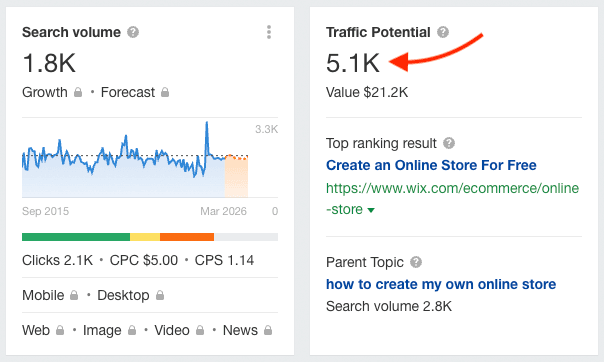
This data lets you spot juicy keywords that you might otherwise have overlooked — and as things stand, you won’t find a similar way to do this using Semrush.
Update: Semrush has recently introduced a similarly named feature — a ‘potential traffic’ metric. But this doesn’t really work in the same way as the Ahrefs tool.
Instead of estimating the total number of clicks it thinks you’ll get if you were to rank number one for a given keyword, Semrush’s ‘potential traffic’ figure shows you how much traffic it thinks your domain can achieve for that phrase if you generally create optimized and well-linked to content for it.
When testing this feature out I encountered some confusing results. For example, for the phrase ‘online store builder,’ it reckoned that optimized content posted on shopify.com targeting this phrase would get just 192 visits (see my screenshot below).

This a much lower number of hits than you might expect given Shopify’s domain strength and topical authority around store building, and it left me scratching my head a little.
4. Ahrefs gives you global search volumes for its keyword suggestions
When you perform keyword research with Semrush, the keyword suggestions you get are provided on a per-country basis only. But it’s often more helpful to see global search volumes for keyword suggestions.
This is particularly the case where English-language keywords are concerned, because use of English for search queries is not just restricted to English-speaking countries.
Unlike Semrush, Ahrefs accompanies all its keyword suggestions with global search volume data, meaning that you get a much more holistic picture here.
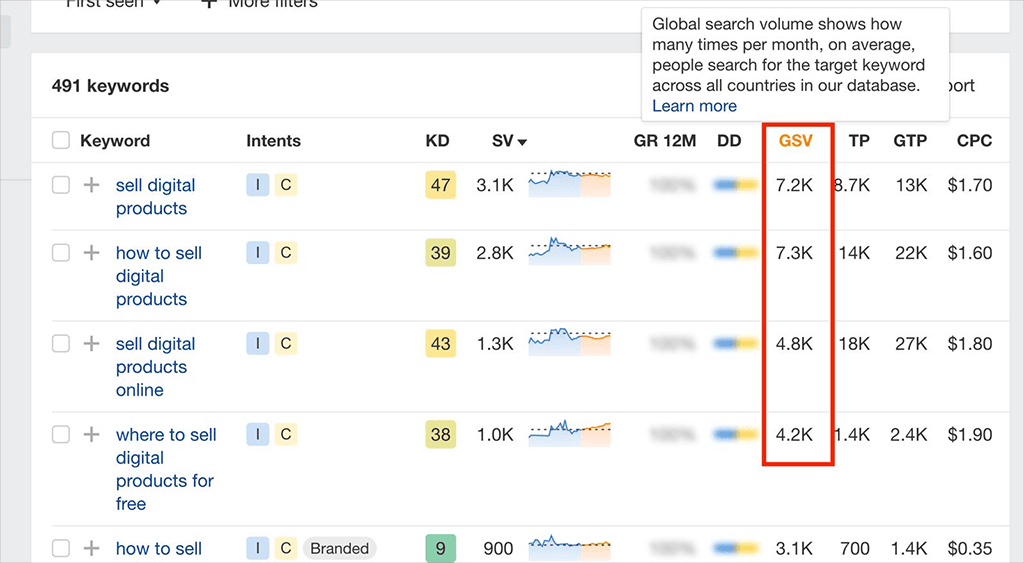
For me, this is one of the most significant edges that Ahrefs has over Semrush. When I’m performing keyword research for Style Factory projects, I nearly always want to see the total number of searches for the keyword suggestions I’m given.
5. Ahrefs gives you more detailed SERP analysis
When it comes to giving you an overview of the sites that are currently ranking highly for a given keyword in search results, I’d argue that Ahrefs does this better. This is because when it lists the top-ranking sites, it accompanies them with more data.
Semrush gives you five bits of ‘ancilliary’ data beside each top-ranking page, namely:
- the authority score of the site that the page belongs to
- the number of referring domains pointing to the URL
- the number of backlinks pointing to the page
- the estimated organic traffic to the page
- the number of keywords that the page ranks for.
There’s a screenshot of these metrics below:

But Ahrefs gives you 10 pieces of data beside each search result — in addition to the metrics provided by Semrush, you also get the following information from Ahrefs:
- an authority score for the domain that the ranking content is on (‘DR’)
- the estimated value of the page’s monthly organic traffic
- the top keyword the page ranks for
- the monthly number of searches for that top keyword
- the word count of the ranking page.
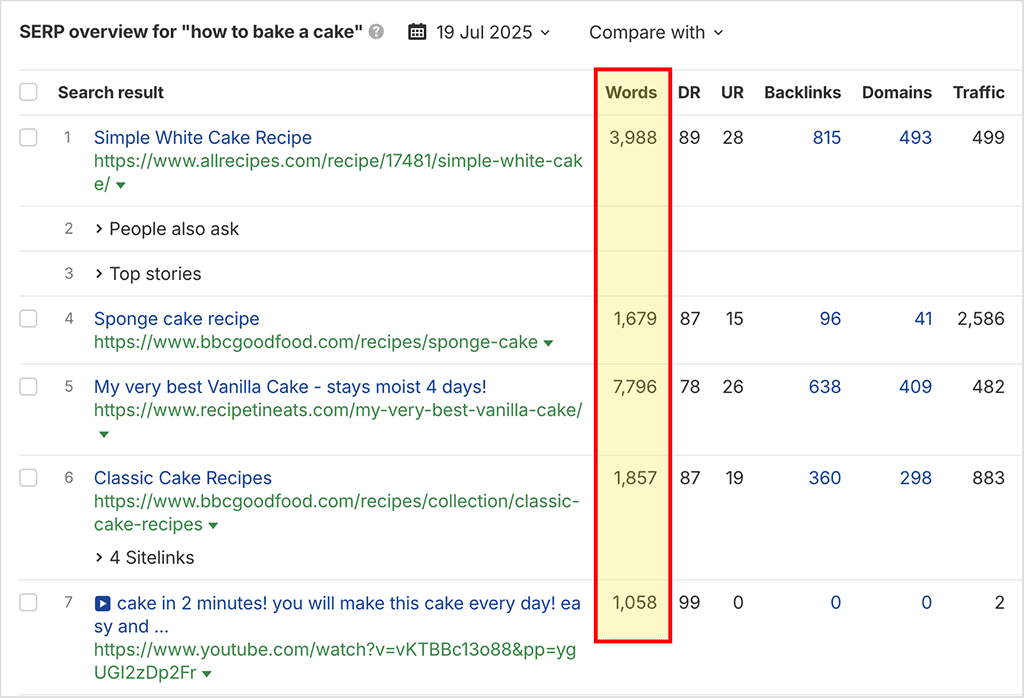
6. Ahrefs gives you more search intent data than Semrush
Semrush and Ahrefs both give you context about why users perform particular searches, thanks to useful ‘search intent’ categorization. As part of the metrics returned for a particular keyword, you’ll see an ‘intent’ box highlighting the context in which a particular search is made:
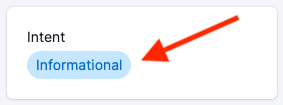
Both tools automatically highlight when the search intent is likely to be ‘transactional’,’navigational’ or ‘commercial.’
These types of keyword search intent are defined by both platforms as follows:
Informational = the user wants to find a specific answer to a question
Commercial = the user wants to investigate brands or services
Navigational = the user wants to find a particular page or website
Transactional = the user wants to complete an action (i.e., a purchase or other conversion).
Now, these keyword intent features really comes in handy when you’re filtering keyword suggestions.
When you enter a phrase into Semrush’s ‘Keyword Magic’ tool or Ahrefs’ ‘Keywords Explorer’ tool, you’ll often end up with a very long list of suggested phrases — and this can be rather overwhelming.
But the ‘search intent’ dropdown menu helps enormously here, because it lets you exclude a lot of irrelevant stuff really easily, and focus on the phrases that are most likely to be revenue-generating for your business.
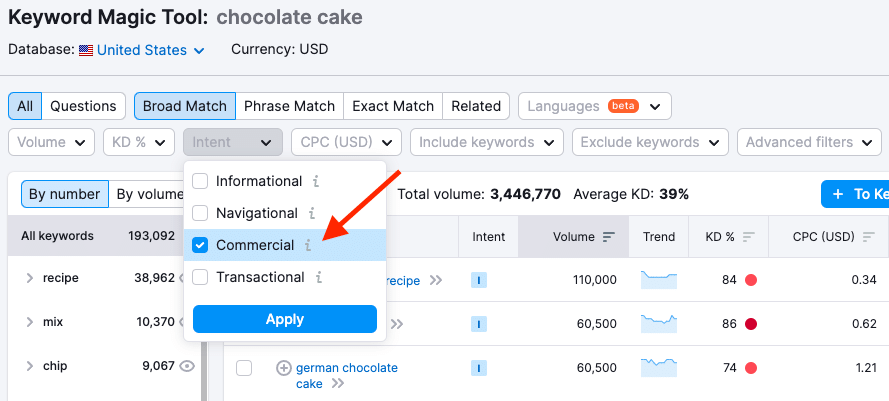
As a simple example of this, you could simply filter keyword suggestions by ‘commercial’ intent to view those that are most likely to lead to purchases.
Ahrefs goes one further here, however, by giving you two extra types of intent: ‘branded’ and ‘local.’ As you might expect, these let you spot keywords involving brand names, and keywords that are associated with local searches.
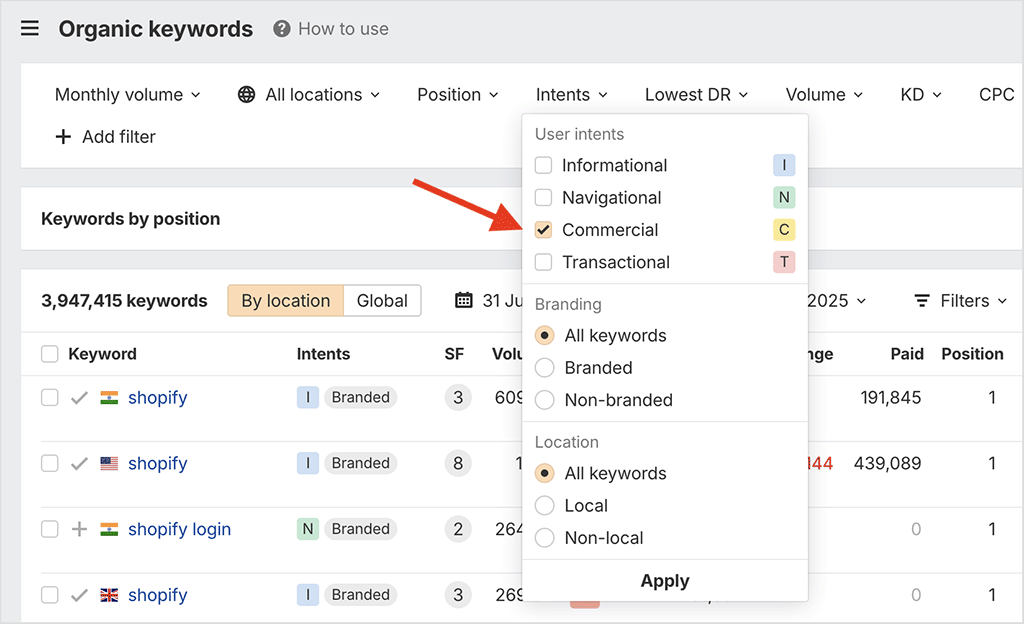
7. It’s easier to spot broken links with Ahrefs
Broken link building is an important SEO tactic.
It involves finding a broken link, recreating the ‘dead’ content that it used to point to, then asking anybody who used to link to the dead content to link to yours instead.
This approach allows you to build up new backlinks to your content — and the more backlinks that point to your website, the better your content is likely to perform in search.
Ahrefs makes it extremely easy to find broken links. You just enter a domain name into its ‘Site Explorer’ section and click the broken backlinks option. You’ll then get a list of all the broken inbound links for that domain — see my screenshot below — and the sites where these links feature.
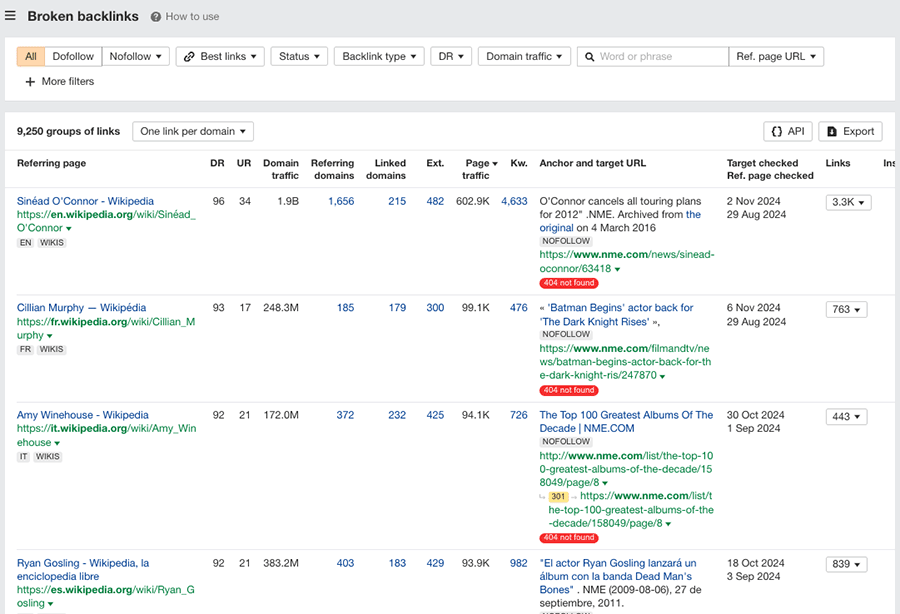
Although you can do broken link building with Semrush too, it involves a more convoluted process. You’ll need to run a backlink analytics report, navigate to an ‘indexed pages’ section, click a ‘broken pages’ option and then export the results to an Excel or CSV file. You can then sort or filter this file to identify the 404 errors (broken links).
8. Ahrefs’ link intersect tool is more generous
A link intersect tool lets you identify websites that are currently linking to your competitors, but not to you. You can use this information to approach those websites and ask their owners for a backlink.
Ahrefs’ link intersect tool gives you more fine grain information than the Semrush equivalent, because it allows you to compare the link profile of a URL against 10 others, while Semrush limits the comparison to just four.
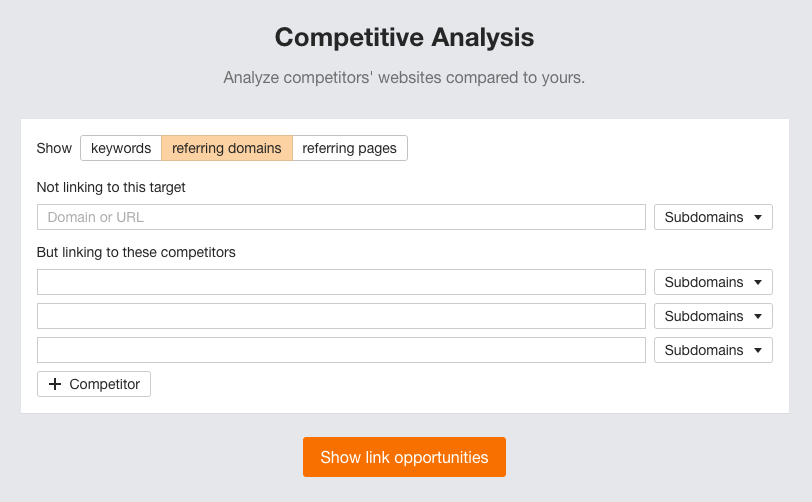
9. Ahrefs’ content gap tool is more generous
Ahrefs’ ‘Content Gap’ feature is also more flexible than the equivalent Semrush feature (its ‘Keyword Gap’ tool).
Both gap analysis tools let you enter your domain and those of some competitors, and show you a list of keywords that your competitor ranks for which yours doesn’t. This gives you keyword ideas for your own site and a sense of the kind of articles you might need to publish in order to achieve ‘topical authority‘ in your niche.
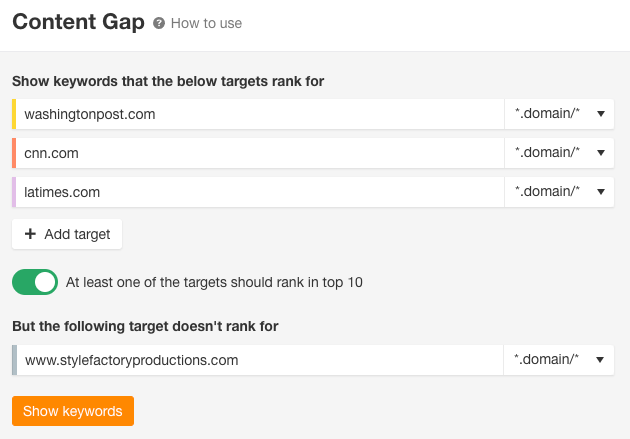
Ahrefs wins here, because its content gap tool lets you evaluate your site against a lot more competing domains (ten versus Semrush’s four).
So those are my key reasons for using Ahrefs over Semrush — now I’m going to look at the reasons you might want to use Semrush instead.
Reasons to use Semrush over Ahrefs
1. Semrush is not just an SEO tool
While Ahrefs is a platform that focuses fairly exclusively on providing SEO data, Semrush goes considerably beyond this.
This is because in addition to providing SEO data, it gives you access to a wealth of online advertising data, market insight data, content marketing features and social media marketing tools. There is also a wide range of apps and integrations available from Semrush that let you extend its functionality in lots of interesting ways.
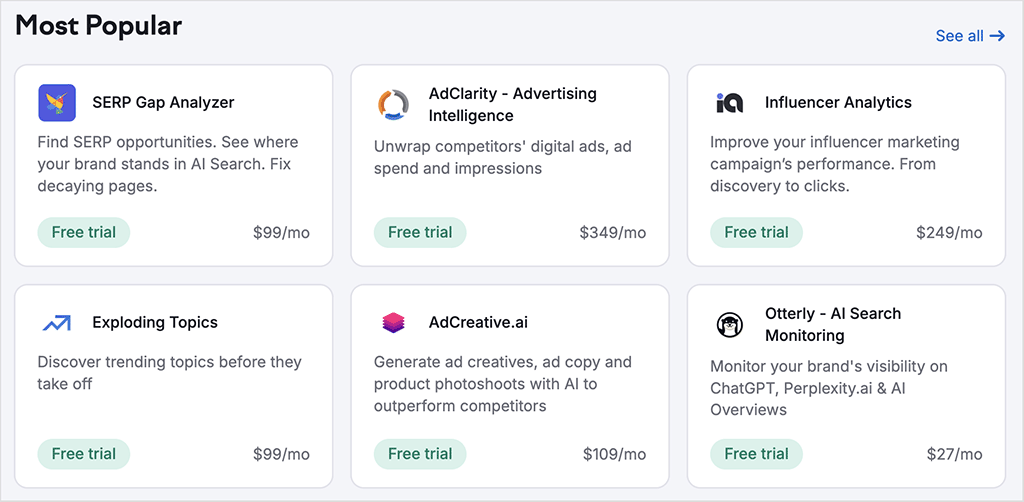
Accessing some of these will involve extra costs (apps typically range from $10/mo to $249/mo in price), but they open up a host of additional marketing possibilities.
A particular edge Semrush has over Ahrefs here relates to pay-per-click advertising data. This is because its comprehensive ‘advertising research’ feature returns a very large amount of Google Ads data, including keywords, ad positions, ad copy, landing page data and more.

Ahrefs does show some PPC related data, but it’s much more limited in scope.
2. Semrush’s entry-level plan is considerably better value than the Ahrefs equivalent
Although the entry level plans for Semrush and Ahrefs are similarly priced, you get a lot more bang for your buck on the Semrush one (its $139.95/mo ‘Pro’ plan).
This is because the Ahrefs entry level plan (its $129 ‘Lite’ plan) caps the number of reports you can pull at just 500 per month, while Semrush lets you pull 3,000 per day.
With more expensive Ahrefs plans, you don’t have to worry about reporting limits at all, but if you’re concerned about costs, and want access to a lot of SEO data at a reasonable price point, Semrush wins.
3. Semrush gives you personalized keyword research data
SEO tools let you know how hard it will be to rank for a particular phrase by giving you a keyword difficulty score. The higher the score, the harder it will be to rank highly in search for that keyword.
However, the keyword difficulty scores provided by most SEO solutions, including Ahrefs, are rather generic in nature — they don’t take account of how strong your domain is, or what its authority on a particular topic is. These are two aspects of a site that can really affect your chances of ranking for a particular query.
Semrush does things differently here, because it lets you enter your domain and factors these two things in to give you a personalized keyword difficulty score (see my screenshot below for an example of this in action).
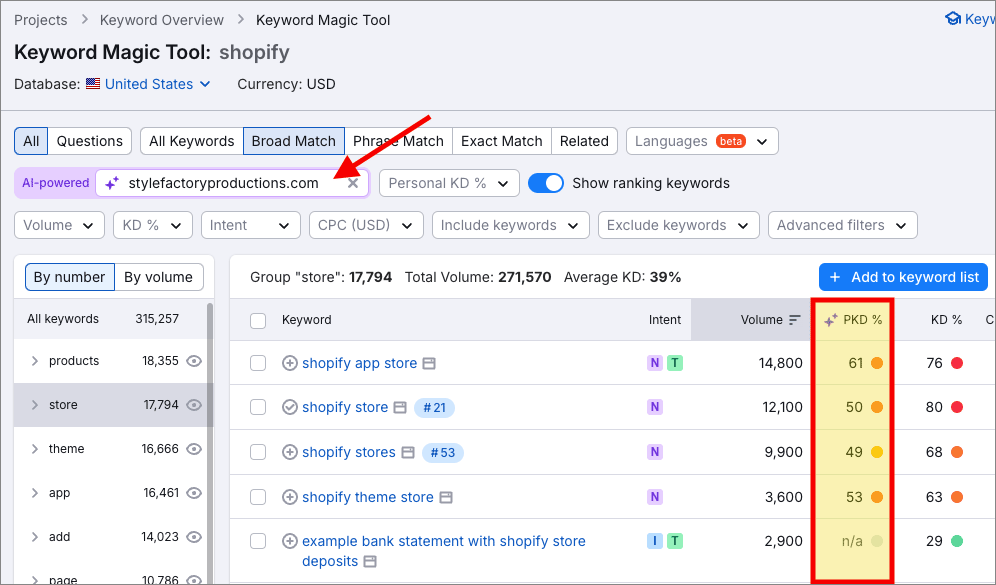
This personalized score more accurately reflects your chances of ranking for a particular keyword, and lets you hone in on the best phrases to target in a quicker, more efficient way. It’s one of my favourite Semrush features, and as things stand, there isn’t anything similar available from Ahrefs.
4. Semrush gives you more data than Ahrefs
Based on publicly available data, Semrush’s link database currently contains 43 trillion links, while the Ahrefs equivalent contains 35 trillion. This means that in theory you should be able to identify considerably more backlink building opportunities with Semrush.
And this was confirmed by my tests on both platforms: as you can see from the table below, when I ran domains through both platforms’ backlink analysis tools, Semrush consistently surfaced more referring domains than Ahrefs.
| Website | Ahrefs | Semrush |
|---|---|---|
| Amazon | 2.2m | 4.4m |
| BigCommerce | 108k | 376k |
| Canva | 390k | 606k |
| Ecwid | 59k | 60k |
| Godaddy | 4.8m | 5.5m |
| Jimdo | 222k | 673k |
| Shopify | 3m | 5m |
| Squarespace | 1.9m | 378k |
| Webflow | 138k | 340k |
| Wix | 1.1m | 3.4m |
As you can see from my data, it ‘won’ 9 out of the 10 referring domain contests.
When it comes to keyword database sizes, the two platforms are fairly evenly matched, with Ahrefs’ keyword database containing around 29 billion keywords, and Semrush’s 27 billion.
Oddly however — and despite Ahrefs’ keyword database being technically the larger of the two — my tests revealed that Semrush consistently surfaced more keyword suggestions:
| Keyword | Ahrefs keyword suggestions* | Semrush keyword suggestions* |
|---|---|---|
| Amazon | 3.7m | 7.9m |
| BigCommerce | 8k | 20.5k |
| Canva | 218k | 1m |
| Ecwid | 1.8k | 5.5k |
| Godaddy | 51k | 157k |
| Jimdo | 2.3k | 4.4k |
| Shopify | 182k | 331k |
| Squarespace | 41k | 131k |
| Webflow | 15.8k | 25.8k |
| Wix | 61k | 210k |
As you can see from the table above, in my keyword suggestion tests, Semrush beat Ahrefs in ten out of the ten contests.
Another thing you get more of from Semrush is historical data — this goes back to 2012, while the Ahrefs’ database contains data from 2015.
5. Semrush provdes a generative AI tool
Unlike Ahrefs, Semrush gives you access to a generative AI tool, in the form of its AI article generator. This uses a mixture of OpenAI’s technology and Semrush’s keyword data to create content that is ‘pre-optimized’ for search engines.
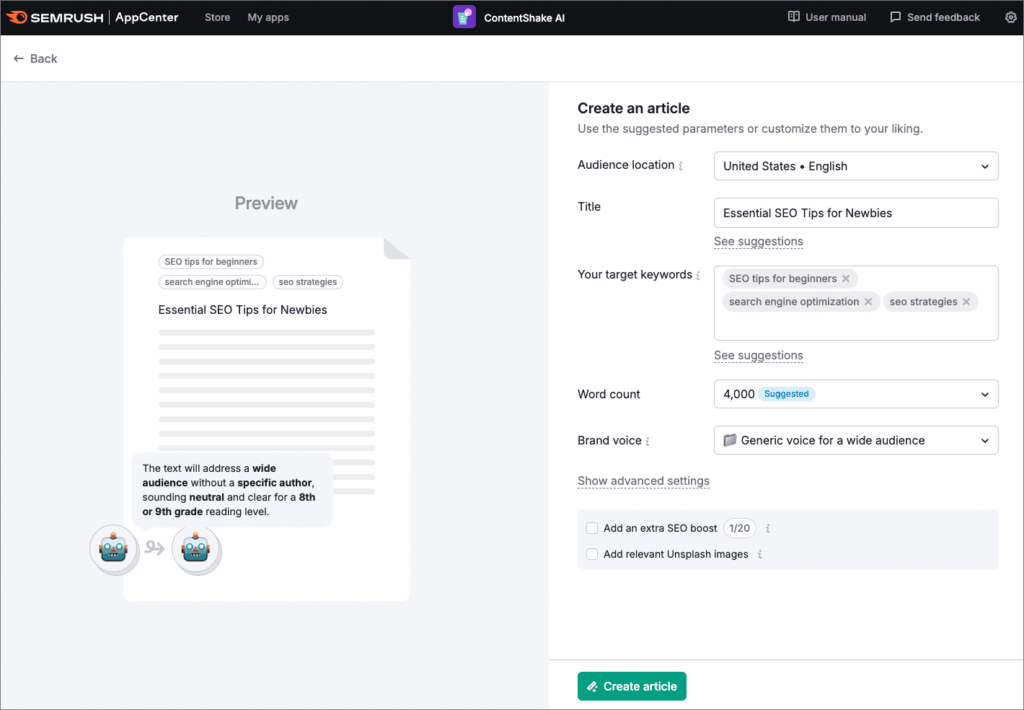
In my tests I found that this worked reasonably well, especially when I was prompting the tool to create factual — rather than subjective or review-based — content.
(However, I still felt that manual editing was required to humanize the output and ensure it was factually correct.)
6. Semrush provides built-in outreach tools
A key part of SEO involves reaching out to other site owners asking them to create links to your content.
And Semrush’s link building tool is superb for this. You give it a URL, and it returns a list of relevant websites to approach about backlinks.
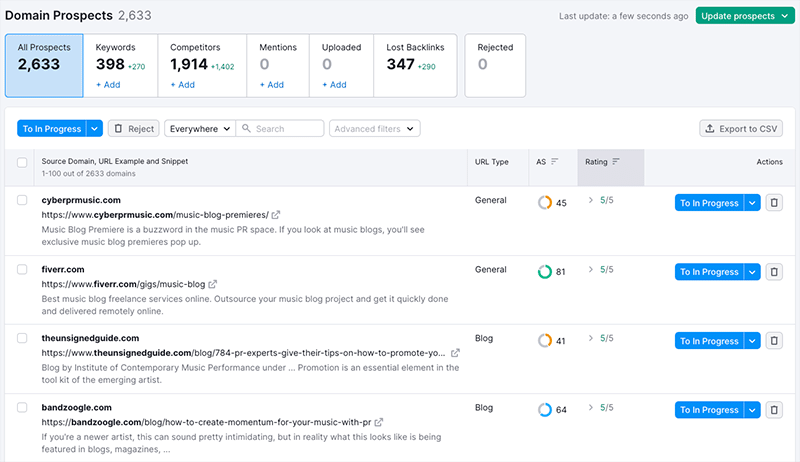
Not only this, but wherever possible, it also surfaces the relevant contact details for those websites.
And on top of that, it gives you a built-in CRM style tool to manage the whole outreach process. You can connect this to your email account and do all your link building directly within Semrush.
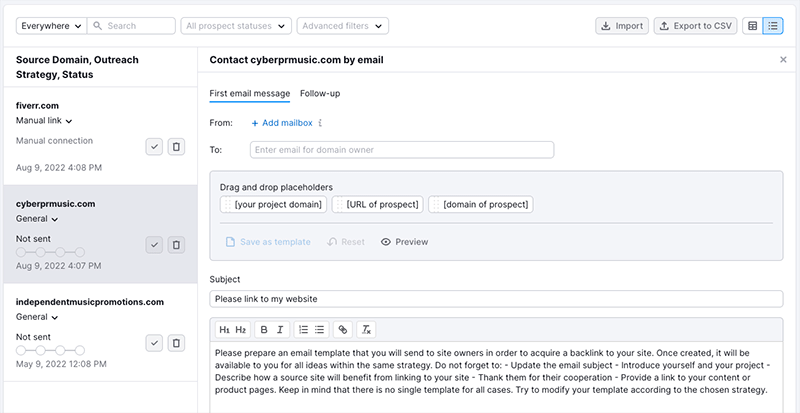
Although Ahrefs does provide you with good tools for identifying backlink opportunities, there’s no comparable outreach system included with the product.
7. Semrush gives you daily rank tracking reports
Rank tracking lets you monitor how your target keywords are performing in search results over time, and helps you take action when a piece of your content suffers a drop in search visibility.

Semrush has an edge over Ahrefs here, because it lets you access daily rank tracking reports that let you respond to drops or improvements in rankings immediately. By default, Ahrefs only gives you weekly ones.
If you do want to get daily rank tracking reports in Ahrefs, you’ll need to pay for an expensive $200 per month ‘Project Boost’ add-on fee, which is far from ideal.
8. Semrush provides more customer support options
Because SEO tools like Ahrefs and Semrush tend to have a steeper learning curve than most business apps, the availability of support for them is very important.
And Semrush wins hands down here. First off, it gives you access to phone support, which isn’t available at all from Ahrefs.

Second, its online support materials come in considerably more languages — they’re available in 14 different languages, while the Ahrefs help portal only caters for five.
9. Semrush’s site auditing features are more comprehensive
Both Ahrefs and Semrush give you excellent SEO auditing tools. These highlight issues that might be having a negative effect on your search rankings, including:
- Slow-loading content
- Duplicate content
- SSL problems
- Crawl errors
- Missing headers
- Overuse of keywords
- Broken links
However, during site audits, Semrush doesn’t just focus solely on technical issues — it considers content too.
Its on-page SEO checker goes through your whole site and gives you actionable tips for improvement for each page (in order of priority). These can include suggestions on:
- which keywords to add
- steps you can take to make a page appear as a Google ‘featured snippet’
- how to improve your body copy and meta descriptions
- which websites to approach for backlinks
- length of content
- internal linking strategies
…and much more.
By default, there isn’t really an equivalent feature in Ahrefs. Any suggestions provided regarding how to improve pages are of a more technical nature — i.e., you won’t get the ideas for improving your content or link profile that Semrush also provides.
Another neat touch that you’ll find in Semrush’s site audit tool that isn’t present in Ahref’s is the ability to send SEO tasks that the system has identified as needing attention to the widely-used project management tool, Trello.

10. Semrush gives you access to generous free trials
As I mentioned above, SEO tools tend to be harder to get to grips with than a lot of other business software. And for me this makes the availability of free trials a crucial consideration — it’s essential that users are able to test a platform, and see how challenging they find its interface, before committing to it.

Although Ahrefs does provide some helpful free tools and resources, it doesn’t give you access to a proper free trial. Trying it out always involves paying for at least one month’s subscription.
By contrast, Semrush gives you access to all its key features and data as part of a fully-functional free trial.
Tip: the links below take you to exclusive extended free versions of both its entry-level ‘Semrush Pro’ plan and its more sophisticated ‘Semrush Guru’ plan.
User reviews of Ahrefs and Semrush
So far you’ve heard my take on Ahrefs vs Semrush. But what do real-world users think? To find this out I compiled user review data from popular review sites. Here are my findings:
| Site | Ahrefs Rating (out of 5) | Semrush Rating (out of 5) |
| Capterra | 4.7 (579 reviews) | 4.6 (2,301 reviews) |
| G2 | 4.5 (566 reviews) | 4.5 (2,697 reviews) |
| TrustPilot | 2.0 (282 reviews) | 2.7 (971 reviews) |
| TrustRadius | 4.6 (387 reviews) | 4.4 (764 reviews) |
| Average | 4.0 | 4.0 |
As you can see from my data (sourced in July 2025), the user reaction to both products across the major review sites was very similar, with both platforms scoring an average user rating of 4 out of 5.
(It is worth noting however that the Semrush score was based on considerably more reviews).
Ahrefs vs Semrush: the verdict
For me, Ahrefs is probably a better choice for agencies or large companies that manage multiple websites. This is because it lets you work with an unlimited number of verified domains and, on its more expensive plans, lets you access an unlimited number of reports. If you’re doing SEO at scale, Ahrefs can be considerably better value than Semrush. You can try Ahrefs here.
If you’re a solopreneur or a small business however, I’d argue that Semrush wins. Its entry-level plan — the most affordable option for such customers — is far more generous in terms of reporting limits than the Ahrefs’ equivalent. Additionally, because of the advertising data, content creation tools, CRM features and app ecosystem it provides, Semrush can be used as a general marketing platform — the same can’t really be said of Ahrefs. You can get an extended Semrush trial here.
I’ll leave you with a summary of the reasons why you might wish to use one of these products over the other — and if you have any questions, please do leave a comment below!
Pros and cons summary
Key reasons I’d use Ahrefs instead of Semrush
- Its project limits are more generous.
- Its reporting limits are more generous — so long as you’re on a $249+ plan.
- Its ‘traffic potential’ metric gives you a really nice way to spot juicy keywords that you might have overlooked.
- Its keyword suggestions tool lets you see not just per-country search volumes, but global ones too.
- It gives you more comprehensive SERP analysis features.
- It gives you more comprehensive search intent data.
- It’s easier to do broken link analysis with.
- Its ‘content gap’ and ‘link intersect’ tools let you work with more domains than Semrush’s equivalent tools do.
Key reasons I’d use Semrush instead of Ahrefs
- Semrush provides a lot of data relating not just to SEO, but PPC too — if you want a tool that covers both areas, it’s a better option than Ahrefs.
- Its entry-level plan is more feature rich than the Ahrefs equivalent, and lets you pull considerably more reports than it.
- It gives you personalized keyword research data.
- Based on my tests, it tends to surface more backlinks and keyword suggestions.
- Unlike Ahrefs, it gives you access to generative AI tools (albeit for an additional fee).
- Semrush’s CRM-style approach to outreach means that you can create really great link building campaigns without ever leaving the app.
- Semrush doesn’t charge you extra for daily rank tracking notifications — getting these is extremely expensive in Ahrefs.
- Phone support is available for Semrush — but not for Ahrefs.
- Its site auditing features are more comprehensive and easier to use.
- A totally free and fully-functional trial is available — this is not the case with Ahrefs.
Alternatives to Semrush and Ahrefs
Semrush and Ahrefs are not the only options when it comes to SEO software. Alternatives include:
- SpyFu
- GrowthBar
- SE Ranking
- Moz
- Serpstat
- Mangools
- SEO Power Suite
- Majestic SEO
- Ubersuggest
- Google’s keyword planner (this becomes available for free when you advertise on Google)
For more information about how Ahrefs and Semrush compares to Moz, do check out our Ahrefs vs Moz vs Semrush comparison (you may also find our Moz versus Semrush comparison and our Moz vs Ahrefs shootout helpful).
We also have a SE Ranking vs Semrush comparison available; a Semrush vs Similarweb shootout; and a ‘quick guide’ version of our Ahrefs vs Semrush shootout that can be accessed on LinkedIn.
Recently, we published a review of Ubersuggest and an Ubersuggest vs Semrush comparison.
To learn even more about Ahrefs and Semrush, you can check out our full Ahrefs review here, watch our Ahrefs video review here, or read our full Semrush review here.
If you’re curious about SpyFu, check out our SpyFu vs Semrush blog post here (we also have a YouTube comparison of the two tools available).
And finally, to learn more in general about how to optimize a website for search engines, do check out our ‘how to do SEO’ guide.
Update details
This comparison was last updated on 31 July 2025. Key changes included:
- Several product screenshots were updated.
- Updates of the data resulting from the tests on the Ahrefs and Semrush keyword and backlink databases.
- New user rating and reviews data was added.
Comments (26)
Dear Chris, we are a small web agency in Greece. Our main problem is that competitors (?) are building a lot of spammy backlinks to specific keywords/pages on our site, for keyword manipulation purposes or to increase our website’s spam score. So what is the best tool we can use to find new spammy backlinks? What do you suggest according to your experience? So many thanks!
Thanks for your query Kyriakos. Of the two tools being discussed here, Semrush gives you more insights into dodgy links, because it has a dedicated tool for doing so (its ‘backlink audit’ tool, which highlights ‘toxic’ links and lets you use Google’s disavow tool to report them). That said, Google claims to ignore spammy links these days (and discourages site owners from disavowing anything unless they receive a manual penalty), as it’s aware of the fact that competitors and bots can build junk links to your site really easily. There’s a good article about this issue here — I hope this puts your mind at rest a bit.
Chris – great comparison! We have a well established NYC restaurant and clientele – 20+ years. We have used social media minimally to attract business. Between these two SEO resources is there one you think will be more optimal (Semrush vs. Ahrefs) for our needs. There is only one user. We should be doing more to increase traction, understanding their spending and dining habits and understanding from what areas our customers come from. We have a intl. and domestic clientele. Thank You. Bob
Hey Bob – thanks for the comment (and sorry for the late reply!). To be honest either of these tools would serve you well in terms of optimizing your website and finding keywords to target (but if there’s only one user involved I suspect Semrush will represent better value for you — you’ll probably be fine on its entry level plan, which has generous reporting limits for one user). To find out where your site visitors are coming from you’d be better served by an analytics tool like Google Analytics or Fathom Analytics, and to understand spending and dining habits you’ll probably need to look at the sales figures on whatever point of sale system you’re using to accept payment in your restaurant. Hope this helps a bit?
I want to start a sports blog and I’m wondering what you think is more suitable for me as a newbie ?
Hey Moh, thanks for your comment. Both tools have a similar learning curve; Semrush has an edge when it comes to pricing for newbies, however, as its entry level plan gives you more generous reporting limits. The main reason I’d go for Ahrefs over Semrush is to get access to its ‘traffic potential’ metric, which is a truly great feature (see details in the review above). But Semrush’s keyword intent tool – which is also really useful – is something that’s missing from Ahrefs! It’s a hard call, and my advice would be to try both out to see which you prefer before making a decision. But if you’re looking at it solely from a financial point of view, you’ll usually find that you get more bang for your buck with Semrush.
How do check DR in Semrush?
You need to look for the ‘Authority Score’ metric – this is Semrush’s equivalent of DR. You should see this when you perform domain analysis in Semrush. Some more details here: https://www.semrush.com/blog/semrush-authority-score-explained/
I have a few websites, all based on the same type of service. Auto Driveaway. Which one would be best, and most affordable, for someone with between 30k-40k visitors per year? I would love to be able to increase my traffic, through better knowledge and therefore better search results. Its overwhelming to say the least.
Thank you
Hi Mark, thanks for your query – yes, it can be tough deciding between these two products. My general take is that if your main focus is Google, then Semrush probably offers the most bang for the buck, because its project management tools are really good for managing link outreach (plus it does a bit of contact surfacing for you too).
If you are also doing a lot on YouTube, however, there’s a strong case for going with Ahrefs, as it includes data for the YouTube search engine and several others too.
There’s also the question of which one you find easier to use – I’d suggest trying both, having a play, and seeing if one product or the other jumps out at you as being more user-friendly, easier to understand etc.
Hope this helps a little?
A client just reached out to me and asked this question. I basically said in a sentence what you said over 4,000+ words; it’s a tie you need both 🙂
Thanks Simon – although I think one of these product will probably suit a lot of users perfectly well. Really depends on the context and whether you need access to non-Google search data.
Wonderfully unbiased piece, thank you. Started the trial for both. Have you looked at Sitebulb for the audit piece? It was recommended to me.
Thanks for the feedback Melanie! Haven’t tried Sitebulb yet, no, but will aim to look at it as we expand our SEO tool reviews section 🙂
Nice detailed comparison of the two most used tools in the SEO industry. I think you should include some result output comparison though?
Thanks Vitthal, will aim to do this in future updates of the post!
Hello Chris, To be honest, Your Semrush and Ahrefs review and comparison is really genuine. You did not promote anything here and it’s natural flow.
However, I would like to use SEMrush. But after reading your guide, I’m happy that I’ve chosen SEMrush already. 🙂
Thanks SaranSaro
Thanks for the positive feedback on the comparison SaranSaro 🙂
Hey, Nice detailed comparison of the two most used tools in SEO industry. I think you should include some result output comparison. For example, if you do a keyword research the result returned should have been compared.
Thanks Sanjay – will look at this in a future update! Appreciate the feedback.
Very helpful report, thank you. A key element for me is the visualisation aspect (for senior reporting to non-digital types).
I love and use both. As you said both are good at different things. They’ve both come in so much in the last 3 or so years too. I’ve used Ahrefs since the early days when it was just about backlink and SEMRush when it was SEO Quake and started as a keyword research tool. The other part of my toolset is Screaming Frog SEO Spider. It’s so quick and basic yet provides so much.
Thanks Michael. Screaming Frog is great too – particularly for checking that migrations have gone okay.
I think this is a really detailed report and very helpful, thank you! I’ll definitely need the seo audit and semrush is the winner here. But my feeling in general is that ahref is a bit better. I’m going to try both tools in the next week and decide then.
So after reading all that you don’t answer the question in the title whether or not one is better than the other. Thanks for wasting my time…
Thanks for reading the post and for the feedback Lee. I’d respectfully disagree — the post makes it clear that in certain situations, SEMrush is better, and in others Ahrefs. For a quick summary of those, check out the ‘Reasons to use Ahrefs over SEMrush’ / ‘Reasons to use SEMrush over Ahrefs’ sections at the very end.